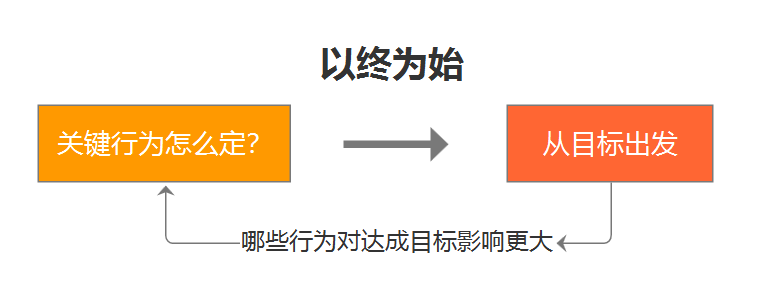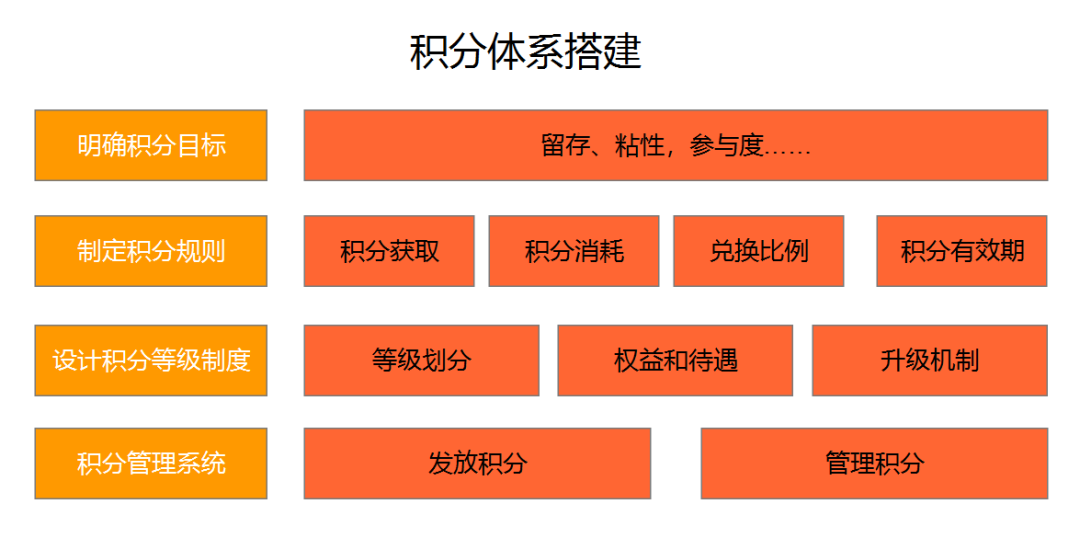
The point system can not only improve user stickiness and participation, but also help us better understand user needs and behaviors, thereby further optimizing product strategies and business models.
1. Theoretical level
1. Clear integral design goals
Before designing points, we first need to clarify the design goals of points, that is, what value this point system can bring to products and users.
According to different product positioning and user needs, the design goals of points will also be different. For example, for a news reading product, the design goal of points may be to encourage users to read more, share more, and increase user interaction and repurchase rate; while for a knowledge sharing product, the design goal of points may be Encourage users to answer more questions, write articles, improve content quality and user stickiness.
2. Consider user psychology and behavior
The design of the point system should fully consider the user's psychological and behavioral habits. For example, users often prefer to earn rewards directly rather than simply accumulating points.
Therefore, in the point system, we should design some activities with direct reward nature, such as check-in, sharing, commenting, etc.
In addition, users are also very concerned about the value of points. Therefore, we need to clearly stipulate the rewards or services that points can be exchanged for, and set the point conversion ratio according to the market value, so as to increase the enthusiasm of users to participate in point activities.
3. Design a reasonable scoring rule
Point rules are the core part of point system design, and a set of reasonable point acquisition and use rules should be formulated in combination with product positioning and user needs. For example, users can get a certain number of points for answering questions, and when the points reach a certain amount, they can be upgraded to advanced users and enjoy more privileges; users can get extra points by sharing articles, and can exchange some exquisite souvenirs or small gifts wait.
2. Practical level
1. Define scoring rules
In practice, we need to define the points rules in detail, including the way to obtain points, the scope of use of points, the conversion ratio of points, and the validity period of points.
For example, we can assign certain points to users for daily check-in, commenting, publishing articles, etc., and then set up some reward mechanisms, such as consecutive sign-in for 7 days, 30 days, 90 days, etc. to get corresponding bonus points.
2. Design a point system
The points grading system refers to the classification based on the number of points and user behavior habits, so as to provide different rights and benefits for users of different levels. For example, users are divided into different levels such as bronze, silver, gold, platinum, etc., and each level has certain privileges and priority services, such as discount coupons, vouchers, etc.
This hierarchical system plays an important role in motivating users to participate in product activities, accumulating points, and improving users' sense of belonging and loyalty.
3. Issuing points and managing points
Issuing points requires the establishment of a complete management system. First of all, it is necessary to formulate the standards and procedures for issuing points, and a dedicated person in charge is responsible for issuing them. Secondly, a points management system needs to be established to count, record and manage the issued points, and ensure the accuracy and integrity of the data. Finally, we also need to regularly conduct user research to collect user opinions and suggestions in order to improve and optimize the point system in a targeted manner.
Of course, the specific plan needs to be adjusted and optimized according to factors such as product type and user group.
3. Construction framework of points system
Let's talk about the overall idea of building a points system in detail:
The point system is a set of operating currency system with subsidies as the starting point.
Subsidies may be money or tokens. It can build a very complete behavior path for users, and promote users to complete these behaviors, so as to achieve the goal of operation. So the key to the point system is to find the key behaviors you want users to reach.
1. How to determine the key behavior

Strongly related to actual product goals. Goals can be retention, activity, payments, referrals, and more.
The user will revolve around the actions set in this system, and his behavior will be regulated, or managed (/User Behavior Management)
For example, the point system when ordering takeout is based on the behavior of placing an order, and the order will be returned, which can be exchanged for red envelopes, and after receiving the red envelopes. In the next consumption, it can be used as cash. By creating an atmosphere where the more you buy, the more you save, let users voluntarily place orders and complete tasks to earn points.
In this way, the user's behavior is managed, so that the user clearly knows what to do in the product, and the user subconsciously follows the product design.
2. What kind of products are suitable for the points system
1) From the frequency of use, high-frequency products
Because you have fewer chances to get in touch with low-frequency products, and users will have fewer behaviors in the product. The improvement of low-frequency products by the integral system is relatively limited.
2) From the perspective of user cycle, products with long retention
Because users of products with short cycles and short retention will soon be lost, and they will soon be useless. The points system doesn't work.
3) In terms of functions, products with rich behavior
Because there is relatively less space for a single behavior to operate.
Therefore, products with the three characteristics of high frequency, long retention, and rich behavior will be more suitable for the point system.
From the perspective of the product life cycle, is the early product more suitable or the mid-to-late product?
The essence of the point system is a set of operating methods, which is equivalent to having a very favorable starting point in the process of operation-points. What were the early goals of the product? It must first verify the product itself, then solve the problems encountered in the product, and then improve the corresponding indicators through operational means to plan the user's use path.
Therefore, the early products do not apply the points system.
3. Specific steps
To build a point system, it is necessary to consider the consumption, acquisition, cost budget, and of course risk control of points.
1) Earn points
Whether the design of the action, and the corresponding incentives, can bring enough value to the business. The behavior of points acquisition is not involved. Subsidies are not the purpose, but the benefits brought about by subsidies are the purpose. Be clear about the ROI of the benefits themselves.
For example, if a content consumption product is not a good match for some users, and they never place an order to pay, then the ROI of the action you design is 0, which is meaningless.
This means that there are problems with the tasks you earn points and the selection of users. Only when both are valuable can the point system be turned on. Users like it very much, but there is a problem with the behavioral design of points acquisition, which is of no value to the business. There is no problem with the user's behavior and it is valuable to the business. However, there is a problem with the consumption guidance of points and the design of this consumption prize, and users will not pay for such incentives at all.
a. The goal of the point system must be defined first, and then the action of point acquisition should be designed according to the goal.
How to set the goal: You have to figure out what core indicators to improve through the points system.
How to set the action: The most commonly used ones, for example, to improve retention, generally use points for signing in. In other words, completing a certain key behavior will earn you points. For example, in the products that are often seen, these two are actually available. For example, it may be points for successful referrals, points for successful orders, points for reading for n minutes, and so on. No problem, but not fine enough.
Therefore, the point system is essentially an operational system, and it is not a user demand in itself. Points are just grabbing. Therefore, we must grasp the relatively most critical things through this grasp, seize opportunities, and grasp growth points. Then it should be when we discover some problems in the business, or when we want to make users generate more behaviors through a certain action, we must give these key users key incentives in these key places, This is the core of refined operations. These key points are critical and must be identified accurately.
How to be more precise? Based on user grouping, find different users who face different problems. To find these key behaviors, distinguish behaviors, and be exclusive to key behaviors. The exchange of some prizes has action restrictions. Then the core action can be disassembled. When these are clarified, a scoring system with higher ROI can be established. Otherwise, the general subsidy is quite a coin.
Some people have to do this action by themselves, because he sprinkled it, but it was a waste of cost. But we give ambiguous users, some so-called key users in the business, incentives for their key behaviors. In terms of income, the ROI must be higher.
b. How to quantify how much an action is worth?
It can be calculated based on the goal of ROI or the relationship between the action itself and the income.
It can be calculated based on the cost of the business, that is, how much the business is willing to pay for this behavior of the user.
for example. For the first purchase cost, we see that there will be instant discounts and subsidies in many cases. The logic is that I am willing to spend my cost on this place, my customer acquisition cost, refer a person, how much money he gets, this money is usually paid by the growth department, he has CAC himself, so this part can also be used CAC, the money originally paid to the channel is directly paid to the user. In this way, the behavior and the points are matched, and through the relationship between the points and the money, the behavior and the money are matched.

2) How to calculate the budget of points: how much these incentives cost, you must know the value of each action
a. Look at the benefits behind this value.
For example, a successful referral will bring a new user and an LTV of 1 yuan. At this time, the incentive can be set without loss. For example, since the LTV is 1, then the CAC only needs to be <1, and it costs 1 yuan to acquire a user.
So how do you know how many actions are shared at a time? Because you know that every time you share the follow-up funnel, the subsequent addition of a new user is 1 yuan, so you can naturally calculate how much a share is. Calculated by the conversion rate, you may share 1 dime or a few cents at a time, so that you can correspond to this point.
b. LTV means that the company stipulates that the cost of a user cannot exceed 50 cents. Then you can only use 0.5 to calculate, this is the cost that the business is willing to pay. Based on this and then calculate back, how much money is needed for a share can be calculated.
When you know the value of an action, you can estimate how many such actions users will have in the product in the future, and then you can set a point budget.
Of course, the actual budget of the point system is much more complicated than this, and a lot of data needs to be run. According to the user scale of different user groups, the user scale corresponding to the triggering of key behaviors to be incentivized, the inflation coefficient, etc., will be calculated later. Expand and organize.
3) Consumption of Points
It is necessary to know whether the design of point consumption is attractive to users.
For many products, a set of so-called tokens is designed, and in the end the commodities exchanged by the tokens are not attractive. That means that the stimulus for the user's behavior is not strong enough. If the stimulus is not strong enough, the purpose of managing user behavior will not be achieved, and naturally your product purpose will not be achieved.
Generally, it is consumed through the Points Mall. So what can pull and guide the behavior of these users?
Selection of products, does the category attract users?
Exchange price.
In his heart, the user will measure the value of the prize he gets with his behavior. If the gap in his heart is particularly large, the user will not do it.
How is the exchange price determined?
You have to set the selling price first, go to the selling price, and then set the exchange price, as long as your selling price is reasonable and every action you take is relatively reasonable.
Selection of products in the mall: The selection of products in the mall is divided into three parts:
It is to do price-anchored products, such as mobile phones and other electronic products. The supply of these products is limited and is mainly used as a price anchor.
Premium goods are goods whose cost is much lower than the selling price. such as virtual goods. IP products, such as the previous vipkid, his IP is very popular among children. A plush toy itself may cost ten yuan, but after adding its IP, it may cost fifty yuan. That is equivalent to reducing the cost of points through this kind of commodity negotiation.
Collaborative goods.
In addition, points can also be consumed through lottery draws, and points will be consumed faster by lottery draws. Because the lottery has a probability. Of course, the probability of the lottery draw must be calculated well, otherwise the experience will be poor.
Then there is passive consumption, all points have a validity period. Because in essence, points are an arrears from a financial point of view. This part of the money should be paid out. It will not be included in the profit. So points must be valid. In addition, it is very important to design an anti-cheating strategy.
Let’s briefly talk about the membership system. The essence of point membership is to build a growth system for users to further promote users’ pursuit of points.
The point system should be regarded as an incentive system. The incentive system itself also has its own set of design methods. The general incentive system can maximize its effect after the growth path of typical users in the product is clear or the closed loop of usage habits is formed. Only at this time can a complete incentive system significantly amplify the efficiency of growth through productization, otherwise it may only be called single-point incentives at best. Or you can cooperate to gradually improve the incentive system before the growth path is clear (in the process of optimizing the path).
Fourth, give a chestnut
Finally, take a content product as an example to explain how to build a point system (not the actual point system of the platform, but just to provide a way to build it):
Taking a content-paying App product based on comic reading as an example, the platform realizes the diversification of comic content and meets the preferences of users of different genders and ages by signing contracts with many comic organizations and original creators (two-dimensional users: mainly 25 years old The following users, such as universities, middle and high school students mainly).
Before building the point system for the comic APP, we need to first clarify the point design goals, formulate reasonable point rules according to user needs and behavior habits, and design preferential policies and reward mechanisms to improve user stickiness, increase user participation and loyalty.
Specifically, we can start from the following aspects:

1. Clear integral design goals
Assume that the goal of the platform’s points system is to increase user stickiness and participation, and at the same time help the platform better understand user needs and behaviors, thereby further optimizing product strategies and business models.
Therefore, the goal of point design can include: to motivate users to register, log in, comment, share, etc. etc.) to increase user participation; encourage users to purchase comics, recharge, open membership and other high-value behaviors, improve user loyalty and willingness to pay; use the points system to make personalized recommendations, attract more users and increase repurchase rates, etc. .
2. Formulate reasonable scoring rules
Point rules should meet user needs and behavior habits, which can motivate users to actively participate, but not make users feel too cumbersome and boring. Specifically, the following points can be considered:
Acquisition of Points: Users can earn points by registering, logging in, checking in, sharing, commenting, inviting friends, etc. Among them, the sign-in function can be limited daily, allowing users to accumulate points rhythmically.
Consumption of Points: Users can use points to purchase comic works, open membership, redeem physical prizes, etc. While ensuring profits, the platform can also set some works as points topics to encourage users to use points to purchase.
Points conversion ratio: The platform can set a reasonable point conversion ratio according to market conditions, for example, 1 point = 0.01 RMB (nonsense, just a chestnut, not necessarily this exchange rate). At the same time, some unique gameplay can also be designed, such as limited-time discounts, full discounts, etc., to attract users to participate more in points activities.
Validity period of points: In order to prevent users from idle points for a long time, a certain point validity period can be set, for example, points need to be used within 30 days after they are obtained.
3. Design a point system
The point level system can be classified by the number of points, user behavior habits, etc. Users of different levels can enjoy different rights and benefits. Specifically, the following points can be considered:
Classification: Users can be divided into ordinary users, silver card users, gold card users, etc. (the name is determined based on the actual business), and the evaluation is carried out according to the number of points, consumption amount and other factors.
Rights and benefits: Users of different levels can enjoy different rights and benefits, such as exclusive discounts, priority purchases, free gifts, etc.
Upgrade mechanism: Users can upgrade through channels such as completing tasks, reaching conditions, and spending money.
4. Issuing Points and Managing Points
Integral management requires the establishment of a complete management system to ensure the accuracy and integrity of data. Specifically, the following points can be considered:
Standards and procedures for issuing points: The platform needs to formulate standards and procedures for issuing points, and a dedicated person in charge is responsible for issuing points to ensure that the points issued meet the requirements of user behavior.
Points management system: A point management system can be established to count, record and manage the issued points, and ensure the accuracy and integrity of the data. At the same time, the point management system can also be integrated with other systems to better use point data in later user behavior and product strategy optimization.
User research: It is also necessary to conduct regular user research to collect user opinions and suggestions in order to improve and optimize the point system in a targeted manner and increase user satisfaction and loyalty.
To sum up: the premise of building a point system is to first clarify the goal of building, and then need to consider user needs and behavior habits, and formulate reasonable point rules and grading systems according to their characteristics to improve user stickiness and loyalty. At the same time, it is also necessary to establish a complete set of points management system to ensure the accuracy and integrity of the data, so that the point data can be better used in the later stage of product optimization.
Finally, I established communication groups in major cities. Those who want to join the group can add WeChat: chanpin628 and I will pull you into the group.


Recommended video number
Pay attention to the WeChat public account: Product Liu can receive a big gift package.

··················END··················

Today's report: The Giant Engine Urban Research Institute released the " 2023 China Urban Night Economy Development Report " , download the report and go to the official account: Hardcore Liu Da background to reply " Urban Night Economy " to download the complete PDF file.
Disclaimer: The copyright of the report belongs to the Giant Engine City Research Institute . It is only for sharing and learning. If there is any infringement, please contact the editor to delete it.
RECOMMEND
recommended reading
How often is it appropriate to change jobs?
Interview one-on-one counseling
How is an indicator system for a product built?

Click "Read the original text"
View more dry goods